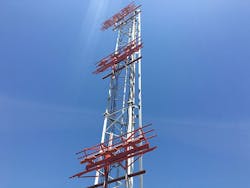FAA chooses ground-based aviation navigation antennas from dB Systems for airspace infrastructure
OKLAHOMA CITY – U.S. Federal Aviation Administration (FAA) RF communications experts needed ground-based antennas for civil and military aviationnavigation and instrument-approach landings within the United States. They found their solution from dB Systems Inc. in Hurricane, Utah.
Officials of the FAA Logistics Center in Oklahoma City announced plans Wednesday to award a sole-source contract to dB Systems for distance measuring equipment (DME) omni-directional antennas, glide slope antennas, and related support equipment. The value of the upcoming contract has yet to be negotiated.
The FAA will order the dB Systems dBs 300A glide slope antennas and dBs 5100A DME omni-directional antenna to maintain critical infrastructure within the U.S. National Airspace System (NAS), which involves the U.S. airspace, navigation facilities, and airports, including those that civil and military aviation authorities share.
The dBs 300A glide slope antennas from dB Systems are part of instrument landing systems (ILS), and help aircraft flying in zero- or degraded-visibility conditions maintain safe approaches to airports in difficult conditions.
The antenna delivers a consistent phase-stable RF signal, and is FAA approved and certified for use in all ILS equipment. Each antenna is phase matched and tested to meet the current FAA standards for low ceiling and limited visibility landings. The antenna has a removable dipole channel assembly to minimize the need for adjustment following antenna replacement.
The dBs 300A antenna transmits specially formed radio frequency (RF) beams in the frequency range of 328 to 336 MHz to enable aircraft with the proper receivers to follow the antenna's transmitted glide slope signal, and can lock on and follow appropriate decent angle safely down to the runway.
The glide slope antenna has three collinear dipoles mounted in front of a 90-degree corner reflector to form its shaped horizontal and vertical patterns. Its radiating elements are heated to prevent ice formation.
The dBs 5100A DME omni-directional antenna from dB Systems, meanwhile, is a broadband 10-element collinear dipole phased array that enables aircraft to measure their distances from the antenna.
Related: Reliable military and aerospace communications depend on advanced antenna technologies
It exhibits low side lobe levels and negative angle radiation to minimize multipath interference, and handles input power to 5,000 Watts at standard DME pulse duty cycles. This Antenna provides vertically polarized, omni-directional coverage with main beam of radiation up tilted to minimize the effects of ground reflections.
The upcoming FAA contract with dB Systems will include antenna pipe adapters and dipole channels.
Email questions or concerns to Rob LaFollette at the FAA Logistics Center at [email protected]. More information about the upcoming contract is online at https://www.fbo.gov/spg/DOT/FAA/MMACTR/DTFAAC-17-R-00102/listing.html.
For more information contact dB Systems Inc. online at www.dbsant.com, or the FAA Logistics Center at www.faa.gov/about/office_org/regions_centers/mmac/logistics.
Learn more: search the Aerospace & Defense Buyer's Guide for companies, new products, press releases, and videos

